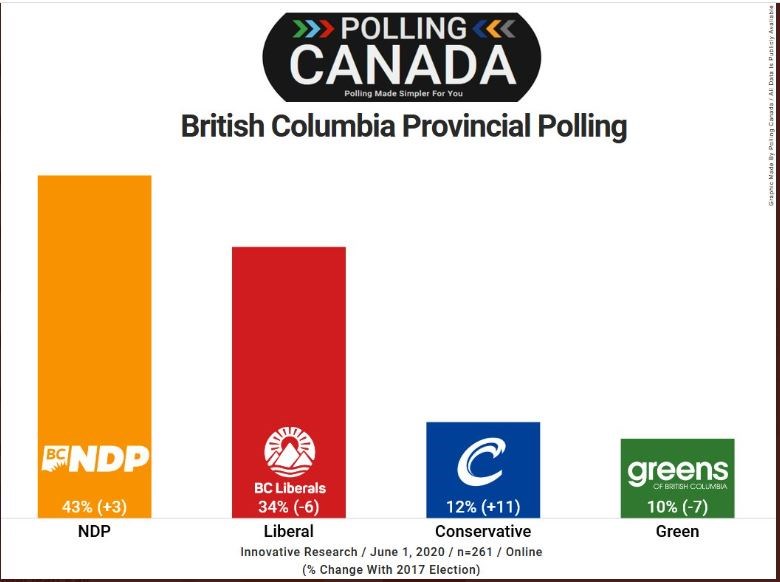A new poll purports to show BC suddenly has four major parties, with the BC Conservatives overtaking the Greens for third place. There are some major flaws with this idea.

Let’s get this out of the way: the sample size was just 261 people. In a province as large and diverse as BC – with deeply pronounced regional voting trends – it’s awfully hard to get a representative sample with that few respondents.
That said, what leaps off the screen is the BC Conservatives at 12% - apparently outpacing the Greens, who won three seats, and are junior partners in a minority NDP government.
No, this number isn’t impossible, in the sense that nothing in BC politics is truly impossible – just highly, highly, ridiculously improbable.
Yes, there is a BC Conservative Party. Yes, the party has a long history, tracing its roots all the way back to 1900. And yes, that history includes several terms in government and as official opposition.
So yes, there’s a real party with real history. Just not a recent one.
Nobody has won a seat under the BC Conservative banner since 1975, the year Canada introduced metric labels. Since then, there has been one high-profile defection, John van Dongen, who was subsequently trounced in the ensuing election. And to save Vaughn Palmer sending me a thoughtful (and welcome) note if I didn’t mention it, after van Dongen left the BC Liberals, technically he sat as an Independent, not as a BC Conservative.
Nothing in BC politics is truly impossible – just highly, highly, ridiculously improbable.
That may be splitting hairs. Instead, consider the last five elections, in which the party garnered 0.15%, 0.55%, 2.10%, 4.76%, and 0.53% of actual votes, respectively. That’s an average of 1.6%. If we included all elections in my lifetime, it would be lower still; the 4.76% “surge” in 2013 stands out as an anomaly.
These numbers aren’t just not in the same ballpark as the NDP, BC Liberals, and Greens, they’re not in the same area code. It’s a similar fringey realm as parties like the Libertarians, Christian Heritage, the Platinum Party of Employers Who Think and Act to Increase Awareness, and because I will take any opportunity to mention them, the separatist Vancouver Island Party, or VIP.
And yet the BC Conservatives continue to be listed as one of four potential voting options in opinion polls, and tend to wildly outpace their actual performance in elections. Why?
The simplest answer is the least flattering – confusion. Put simply, it’s respondents mistakenly thinking they’re declaring support for the federal party.
Is that surprising? Granted, BC isn’t often thought of as a Conservative stronghold, but that’s what happens when you focus on Vancouver. Outside Vancouver and Vancouver Island, the Conservatives have become fairly dominant – again, we’re talking federally – and with the whole province figured in, attract a comfortable plurality of support.
So there’s no shortage of Conservative supporters in BC – just not BC Conservative supporters. This is why the BC Liberal Party occasionally flirts with changing its name. It never happens, partly because there isn’t a great alternative, and partly because the “brand confusion” always seems to dissipate when it counts at the ballot box, so why bother?
There’s no shortage of Conservative supporters in BC – just not BC Conservative supporters.
There’s another, slightly more esoteric answer. Possibly, BC Conservative polling shows voters disenchanted with the BC Liberals, but at election time, either go BC Liberal, or don’t vote at all. In other words, there’s potentially a (very) small market for a viable BC Conservative party, which almost always disperses for fear of vote splitting.
There’s evidence for this. In 2012, at the very high point of looking like the BC Conservatives might just become a thing, two byelections were held in (usually)safe BC Liberal ridings, Port Moody-Coquitlam, and Chilliwack-Hope, respectively. The NDP took both, mostly due to unusually strong performances by BC Conservative candidates.
In was short-lived. In a general election just a year later, both ridings went back to the BC Liberals, again mostly due to the BC Conservative vote receding to historic trends. In Port Moody-Coquitlam, the party didn’t even run a candidate – also a reversion to the norm.
Yes, that was eight long years ago. But again, 2012 was very much a blip, and not particularly representative. You might argue 2012 shows a party can emerge from nowhere to become suddenly significant. And you’d have a point. The BC Greens were once just as small and adrift; now they have three (whoops, make that two) seats. But if that’s the case, why not poll support for the Socreds, VIP, or Judean People’s Front?
The better question seems to be why a moribund party like the BC Conservatives are included in standard provincial polling at all. Could more than a handful of those polled even name the BC Conservative leader? It would be fascinating to see the same respondents (in a larger sample size) asked which of the three major parties they’re likely to support. After all, in 2017 they attracted 97.49% of all valid votes.
Failing that, just provide an option for “other.” It’s less confusing, and more accurate.
Maclean Kay is Editor-in-Chief of The Orca
SWIM ON:
- The BC Conservatives were included in the preview for last year's Mother of All Byelections (tm), in the category "other."
- The BC Conservatives also figured into the referendum on proportional representation, campaigning on the yes side.
- Speaking of a long and rich history, Mike McDonald reflected back on the election that changed everything...eventually.



